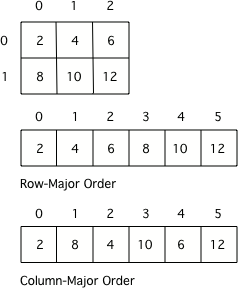In [1]:
String[][] adungeon;
In [2]:
String[][] adungeon = new String[3][4];
In [3]:
String[][] adungeon = {
{"trap", "spider", "treasure"},
{"rat", "gems", "spiderweb"},
{"treasure", "treasure", "gargoyle"},
{"goblin", "pit", "oil lamp"}
}
Arrays get / set value¶
In [4]:
System.out.println( adungeon[2][1] );
adungeon[2][1] = "peppo"; // row 2, column 1
System.out.println( adungeon[2][1] );
treasure peppo
In [5]:
for (int i=0; i < adungeon.length; i++){
for (int j=0; j < adungeon[i].length; j++){
System.out.print(adungeon[i][j] + " ");
}
System.out.println();
}
trap spider treasure rat gems spiderweb treasure peppo gargoyle goblin pit oil lamp
2.1) Nested Loops for 2D Arrays
2.2) Getting the Number of Rows and Columns
2.3) Looping Through a 2D Array
Some formatting example...¶
System.out.printf(format, parameters, ...)
%sis a placeholder for strings%-10sjustifies string left with 10 characters width%dis a placeholder for integers%fis a placeholder for floating point numbers%-10.2fjustifies left with 10 characters width and 2 decimals
In [6]:
System.out.println("Item Quantity Price");
System.out.printf("%-10s%-10d%-10.2f\n", "Cigars", 5, 13.40);
System.out.println();
Item Quantity Price Cigars 5 13.40
Better 2D array printing¶
In [7]:
for (int i=0; i < adungeon.length; i++){
String[] row = adungeon[i];
for (int j=0; j < row.length; j++){
System.out.printf("%-10s", row[j]);
}
System.out.println();
}
trap spider treasure rat gems spiderweb treasure peppo gargoyle goblin pit oil lamp
In [8]:
for (String[] row : adungeon){
for (String cell : row){
System.out.printf("%-10s", cell);
}
System.out.println();
}
trap spider treasure rat gems spiderweb treasure peppo gargoyle goblin pit oil lamp
In [9]:
String[][] adungeon = {
{"trap", "spider", "treasure"},
{"rat", "gems", "spiderweb"},
{"treasure", "treasure", "gargoyle"},
{"goblin", "pit", "oil lamp"}
}
- Does
adungeoncontain some treasure?
- How many treasures does
adungeoncontains?
- At which coordinates (row, column) is the first treasure in each row?
List collections¶
In [10]:
List<List<String>> lsdungeon = List.of(List.of("trap", "spider", "treasure"),
List.of("rat", "gems", "spiderweb"),
List.of("treasure","treasure", "gargoyle"),
List.of("goblin", "pit", "oil lamp"));
In [11]:
// var : type inference (since Java 10)
var lsdungeon = List.of(List.of("trap", "spider", "treasure"),
List.of("rat", "gems", "spiderweb"),
List.of("treasure","treasure", "gargoyle"),
List.of("goblin", "pit", "oil lamp"));
In [12]:
System.out.println(lsdungeon.get(0));
[trap, spider, treasure]
In [13]:
System.out.println(lsdungeon.get(1));
[rat, gems, spiderweb]
In [14]:
System.out.println(lsdungeon.get(1).get(2));
spiderweb
Printing list dungeon¶
In [15]:
System.out.println(lsdungeon);
[[trap, spider, treasure], [rat, gems, spiderweb], [treasure, treasure, gargoyle], [goblin, pit, oil lamp]]
In [16]:
System.out.println(lsdungeon.get(2));
[treasure, treasure, gargoyle]
In [17]:
for (List<String> row : lsdungeon){
for (String cell : row){
System.out.printf("%-10s", cell);
}
System.out.println();
}
trap spider treasure rat gems spiderweb treasure treasure gargoyle goblin pit oil lamp
List array algorithms¶
Does lsdungeoncontains some treasure?
In [18]:
var lsdungeon = List.of(List.of("trap", "spider", "treasure"),
List.of("rat", "gems", "spiderweb"),
List.of("treasure","treasure", "gargoyle"),
List.of("goblin", "pit", "oil lamp"));
In [19]:
int i = 0;
boolean found = false;
while (i < lsdungeon.size() && !found){
found = lsdungeon.get(i).contains("treasure");
i++;
}
System.out.println("found:" + found);
found:true
How many treasures does lsdungon contains?
In [20]:
var lsdungeon = List.of(List.of("trap", "spider", "treasure"),
List.of("rat", "gems", "spiderweb"),
List.of("treasure","treasure", "gargoyle"),
List.of("goblin", "pit", "oil lamp"));
In [21]:
int count = 0;
for (List<String> row : lsdungeon){
count += Collections.frequency(row, "treasure");
}
System.out.println(count);
3
At which coordinates (row, column) is the first treasure in each row?
In [22]:
var lsdungeon = List.of(List.of("trap", "spider", "treasure"),
List.of("rat", "gems", "spiderweb"),
List.of("treasure","treasure", "gargoyle"),
List.of("goblin", "pit", "oil lamp"));
In [23]:
int count = 0;
for (int i = 0; i < lsdungeon.size(); i++){
int j = lsdungeon.get(i).indexOf("treasure");
if (j != -1){
System.out.println("Found a treasure at row " + i + " and column " + j);
}
}
Found a treasure at row 0 and column 2 Found a treasure at row 2 and column 0
Monsters dungeon¶
Using Monster defined as in classes slides
Note for us here a healty cerberus is a monster with the name "Cerberus" and exactly 7 lifepoints.
In [25]:
Monster cerberus1 = new Monster();
cerberus1.name = "Cerberus";
cerberus1.lifepoints = 7;
Monster cerberus2 = new Monster();
cerberus2.name = "Cerberus";
cerberus2.lifepoints = 7;
Monster zombo = new Monster();
zombo.name = "Zombo";
zombo.lifepoints = 4;
List<List<Monster>> mdungeon = List.of(List.of(cerberus1, cerberus1, zombo),
List.of(zombo, cerberus2, cerberus1),
List.of(zombo, cerberus1, zombo),
List.of(cerberus1, zombo, cerberus2));
Does mdungeoncontain some healthy cerberus?
In [26]:
var mdungeon = List.of(List.of(cerberus1, cerberus1, zombo),
List.of(zombo, cerberus2, cerberus1),
List.of(zombo, cerberus1, zombo),
List.of(cerberus1, zombo, cerberus2));
In [27]:
int i = 0;
boolean found = false;
while (i < mdungeon.size() && !found){
found = mdungeon.get(i).contains(cerberus1);
i++;
}
System.out.println("found:" + found);
found:true
How many healthy cerberus does mdungeon contain?
In [28]:
var mdungeon = List.of(List.of(cerberus1, cerberus1, zombo),
List.of(zombo, cerberus2, cerberus1),
List.of(zombo, cerberus1, zombo),
List.of(cerberus1, zombo, cerberus2));
In [29]:
int count = 0;
for (var row : mdungeon){
count += Collections.frequency(row, cerberus1);
}
System.out.println(count);
7
At which coordinates (row, column) is the first healthy cerberus in each row?
In [30]:
var mdungeon = List.of(List.of(cerberus1, cerberus1, zombo),
List.of(zombo, cerberus2, cerberus1),
List.of(zombo, cerberus1, zombo),
List.of(cerberus1, zombo, cerberus2));
In [31]:
int count = 0;
for (int i = 0; i < mdungeon.size(); i++){
int j = mdungeon.get(i).indexOf(cerberus1);
if (j != -1){
System.out.println("Found a healthy cerberus at row " + i + " and column " + j);
}
}
Found a healthy cerberus at row 0 and column 0 Found a healthy cerberus at row 1 and column 1 Found a healthy cerberus at row 2 and column 1 Found a healthy cerberus at row 3 and column 0
Mixed dungeon¶
All classes inherits from class Object, so we can have a mixed list of generic objects:
In [32]:
List<List<Object>> mixdungeon = List.of(List.of(cerberus1, "oil lamp", zombo),
List.of(zombo, cerberus2, cerberus1),
List.of("spiderweb",cerberus1, zombo),
List.of(cerberus1, zombo, cerberus2));
We can also omit Object in the type:
In [33]:
List<List> mixdungeon = List.of(List.of(cerberus1, "treasure", zombo),
List.of(zombo, cerberus2, cerberus1),
List.of("treasure", cerberus1, zombo),
List.of(cerberus1, "treasure", "treasure"));
Mixed dungeon algorithms¶
In [34]:
var mixdungeon = List.of(List.of(cerberus1, "treasure", zombo),
List.of(zombo, cerberus2, cerberus1),
List.of("treasure", cerberus1, "oil lamp"),
List.of(cerberus1, "treasure", "treasure"));
In [35]:
Object obj = cerberus1;
//Object obj = cerberus2;
//Object obj = "treasure";
- Does
mixdungeoncontain someobj? - How many
objdoesmixdungeoncontain? - At which coordinates (row, column) is the first
objin each row?

